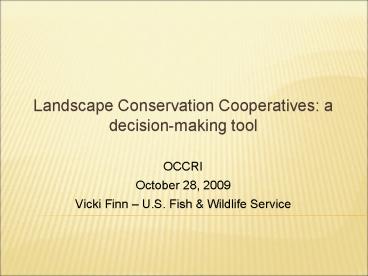Landscape Conservation Cooperatives: a decisionmaking tool PowerPoint PPT Presentation
1 / 21
Title: Landscape Conservation Cooperatives: a decisionmaking tool
1
Landscape Conservation Cooperatives a
decision-making tool
- OCCRI
- October 28, 2009
- Vicki Finn U.S. Fish Wildlife Service
2
Climate Change Strategic Plan
- Organized around Adaptation, Mitigation, and
Engagement - Comment Period closes Nov. 23
- http//www.fws.gov/home/climatechange/
- Dedicated climate change coordinators in each
Region
3
Major Concepts within Strategic Plan
- Species Habitat Vulnerability Assessments
- Risk Assessments for refuges and hatcheries
- National Inventory and Monitoring Program
- National Adaptation Strategy
- Carbon Sequestration as restoration tool
- Landscape Conservation Cooperatives
4
Secretarial Order September 14, 2009
- Establishes Department of Interiors approach
- Climate Response Council (1)
- Regional Climate Change Response Centers (8)
- Landscape Conservation Cooperatives (22)
- All Bureaus to analyze climate change impacts
when making major decisions
5
Climate Change Response Council
- Coordination role with
- CEQ
- White House
- Agriculture
- Commerce
- Defense
- EPA
6
Regional Climate Change Response Centers
- Synthesize and integrate climate change impact
data - Develop decision support tools for Department
managers and partners - USGS lead
- Eight Centers
7
Landscape Conservation Cooperatives
- Collaborative National Network (22)
- Develop landscape-scale conservation strategies
- Focus on scientific and technical support
- Support from Regional Climate Change Response
Centers - Coordinate fish and wildlife adaptation efforts
8
LCC principles
- Steering Committee guides
- States, NGOs, Tribes, Academia, Feds
- Honor existing partnerships while filling gaps
- Link science with managers needs
- Leverage and expertise
- Build together to benefit all
9
Sample of desired climate savvy outputs
- Potential ranges of native invasive species
- Vulnerability assessments for species habitats
- Potential community composition (spp.
assemblages) - Potential refugia and priorities for land
acquisition - Potential corridors linking present and future
habitat - Areas of converging climate and non-climate
stressors - Web-based GIS decision support tools
10
Desired staffing
- Cooperative coordinator
- Science and Technology coordinator
- Modelers (species, fire, and population)
- Planners (Landscape Conservation and Monitoring)
- Geomorphologist and Hydrologist
- Ecologists (Avian, Vegetation, Riparian, etc.)
- Communication/GIS/data product specialists
11
FY 10 Presidents Budget
- State and Tribal Wildlife Grants 40M
- Climate Change Planning (LCCs) - 10M
- Climate Change Science Capacity - 10M
- Partners for FW - 6M
- Refuges - 12M
- Fisheries (National Fish Habitat Plan) - 2M
12
Organizing a National Effort
Aggregate Bird Conservation Regions aquatic
systems to achieve Geographic Areas
- Bird Conservation Regions (BCRs)
2-Digit Hydrologic Units (watersheds) with
4-digit HU boundaries overlaid
13
(No Transcript)
14
(No Transcript)
15
FY 10 LCC Priorities Nationally
- Pacific Islands
- Great Northern
- Southern Great Plains
- Northern Great Plains
- South Atlantic
- North Atlantic
- Northern Alaska
- California/South Pacific
16
Pacific Islands Climate Change Cooperative
17
(No Transcript)
18
(No Transcript)
19
(No Transcript)
20
Conservation in Transition
- Success at individual project sites will not be
sufficient in an era of climate change.
Therefore, the overarching aim of the Service
will be success at the landscape scale, achieved
by leveraging our conservation capacity with that
of the states and the conservation community at
large and attaining biological outcomes larger
than those we could attain ourselves. (USFWS,
2008)
21
Give us your feedback. Help shape LCCs.
- vicki_finn_at_fws.gov
- stephen_zylstra_at_fws.gov
- Assistant Regional Director for Climate Change
and Science Application - carol_schuler_at_fws.gov

